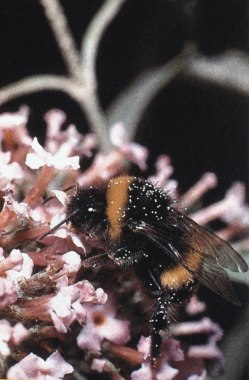

Both species are under pressure of each other to adapt: they undergo evolution together at the same time.
There are many examples of the arms race. Think of plants developing spines or poison in response to eating by animals. Or think of animals and their parasites.
Know more?
Arms race
A somewhat more sympathetic kind of coevolution is the one of the 'flowers and the bees', or the plants and the insects. Plants are (often) dependent on insects for the pollination of the flowers, whereas the insects depend on the plants for their food (honey, pollen). This mutual dependence has gradually increased in the course of time. There are even insect species being totally specialized on one plant species. Some orchids have developed a flower which looks exactly like the female of a certain species of a wasp. They imitate even the smell. Male wasps are attracted by these flowers and take care for the pollination.
Insects are also often involved in the dispersion of the seeds of plants.
The ultimate form of coevolution is the symbiosis in which two organisms live together and cannot live without one another. An example are the lichens, which are a symbiosis of an alga and a fungus.
Know more?
Coevolution